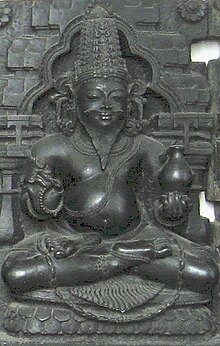Brihaspati
[2][5] Brihaspati appears in the Rigveda (pre-1000 BCE), such as in the dedications to him in the hymn 50 of Book 4;[6] he is described as a sage born from the first great light, the one who drove away darkness, is bright and pure, and carries a special bow whose string is Rta or "cosmic order" (basis of dharma).
[2] In the Vedic literature and other ancient texts, sage Brihaspati is also called by other names such as Bramanaspati, Purohita, Angirasa (son of Angiras) and Vyasa;[3] he is sometimes identified with god Agni (fire).
[8][9][10] While the manuscripts of Brihaspati Smriti (Bṛhaspatismṛti) have not survived into the modern era, its verses were cited in other Indian texts.
[22] The texts slightly disagree in their data, in their measurements of Brihaspati's revolutions, apogee, epicycles, nodal longitudes, orbital inclination, and other parameters.
[5] Brihaspati as Jupiter is part of the Navagraha in the Hindu zodiac system, considered auspicious and benevolent.
The word "Thursday" in the Greco-Roman and other Indo-European calendars is also dedicated to the planet Jupiter (god of sky and thunder).
[30]) The icon of Brihaspati makes his body golden, with his legs striped blue and his head covered with a halo of moon and stars.

